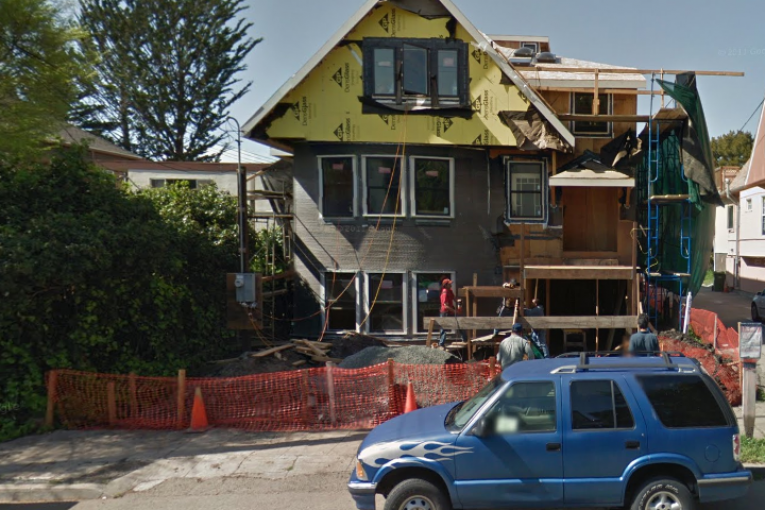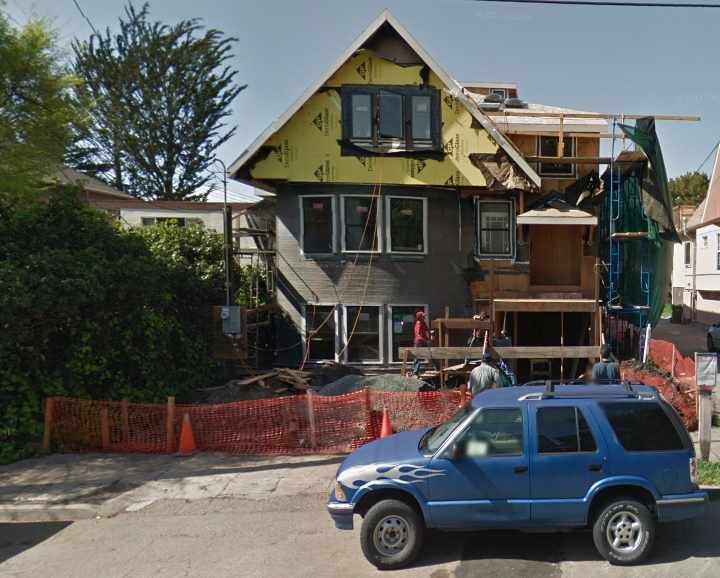

The council on Tuesday passed an urgency ordinance that would require design review for homes that are two or more stories with additions of more than 40 percent of the gross floor area.
Under current laws, if such projects are found to be consistent with existing zoning regulations, they need only request a building permit. Such process permits “no city discretionary review or neighbor notification.” There is, as this indicates, no noticing to the neighbors.
Assistant City Manager Ashley Feeney explained that they have had some concern in that “we have had some homes that are built that are much larger than the existing built environment and some are arguing incongruent with the neighborhood they’re going into.
“We see a lot of pressure around this is,” he explained. “We feel it was right to come back with an urgency ordinance to address some of these concerns.”
There are two proposals currently which are at issue – both propose to take an existing single-family home and replace it with an expanded house or houses. One of these, on Oak Avenue, proposes to have 18 bedrooms.

“We don’t want to have all of the additions covered,” Mr. Feeney explained. “We wanted to go ahead and capture larger additions… Really looking at the additions that cause the most concerns. Forty percent is the sweet spot where we will have the design review.”
Mr. Feeney explained, “Neighborhood noticing and due process” is “really the chief concern when neighbors are surprised by new construction, especially when it’s large and out of scale.”
The plan is to bring the ordinance back to council to approve it as a permanent ordinance in the future.
The item, even as it was late in the evening, drew a fairly large amount of public comment – much of it focused on 201 Russell Boulevard, which was a recent approval that met all of the current regulations, but was massive and the noticing was insufficient. Moreover, the neighbors had no recourse under existing rules – they did not have the right to public appeal to either the Planning Commission or City Council prior to enacting this ordinance.
A long-time neighbor said, “It’s very worrisome to see the addition to 201 Russell and the ease in which it went through the permit process by the city. We are all wondering why the planning department okayed it in the first place and then didn’t bring it to the attention of the city council.”
Another neighbor noted that “there are only a very few streets that all of this can go along on. Every one of them has been brought up tonight, at least in the ones I know.” She pointed to A Street, Miller Drive and Oak Avenue. “We look at this one going up now on Russell and Miller, we’re concerned, we don’t know what’s going to happen to it. But it’s out of size with the rest of the neighborhood.”
She argued that impact on the neighborhood should be a consideration, stating that “if you turn over enough of those on the street, you’ll say it doesn’t matter any more. It’s already gone. Never mind.”
Another neighbor spoke about 525 Oak Avenue, and there is a group of about 30 neighbors in opposition to that project, he explained. This is a large lot, he said, that is actually two lots put together to be two-thirds of an acre.
In August, there was a proposal to build a five-bedroom, five-bathroom house with a three-bedroom ADU (Accessory Dwelling Unit) on the front lot, and a ten-bedroom, ten-bathroom duplex on the back lot. “A total of 18 bedrooms,” he said. This would replace a three-bedroom house that was on that lot.
“That proposal was withdrawn, it was not viewed very favorably by members of the Planning Commission,” he said. However, the owner is now proposing a 14-bedroom project on those two lots – two five-bedroom houses and two two-bedroom ADUs.
“That could be done ministerially with the present regulations,” he explained. “That’s an example of a very specific situation where a review like this might give the neighbors an opportunity to take a look and give it a design review.”
Henry Bennett, who lives on Oak Avenue, called it a “useful tool to support the community on a broad front,” and noted “the risk that trying to provide the housing that the university needs by progressively going through neighborhoods and reconfiguring them.” He said, “This is a tool that I think tempers some of these activities.”
Another lady stated that “there are many more concerned with this issue than are sitting here in the chamber tonight. Anybody in the old neighborhoods who has a mini-dorm next door to them is concerned with this kind of an issue.”
Mayor Pro Tem Gloria Partida proposed that they no longer use the term “‘dorm’ in any of our noticing ever again.” She said, “We’ve got this history of pitting students against the rest of the people in our community, it’s taken on this very bad connotation.”
Dan Carson said, “We’ve worked hard to get city and voter approval for 4000 rental units in this town, we’ve worked hard with the university to get 5000 additional on-campus units in just the next five to six years. We care about providing housing for students, and our citizens in general, but we need to be careful about the impacts in our neighborhood.”
He said that “there’s no denying they have quality of life impacts.”
Lucas Frerichs agreed with the point about building housing especially for students, saying that “this is not a student issue at all, it’s a quality of life in neighborhoods issue.”
While this is a city-wide ordinance, the areas most affected are the central neighborhoods, those immediately adjacent to the university.
“There is a need for more scrutiny for these large expansions,” he said. “There might not be more than 20 a year, but the ones that have been coming in are in definite need of additional scrutiny.”
“Our zoning needs to evolve,” Mayor Brett Lee stated. He said that a few years ago they never would have seen this type of proposal. “While it’s still the exception, it’s no longer just one every five years.”
People are trying to turn a sizable profit by converting houses into ten bedroom homes, “disregarding what’s appropriate for the context of the neighborhood.”
—David M. Greenwald reporting


“it’s a quality of life in neighborhoods issue.”
I wish the City Council majority had made this realization with regard to the Trackside project in Old East Davis.
Have you seen the new apartment complex on B just north of 8th? It is a nice addition to the neighborhood and I’m sure the folks living there are happy to have an appropriate place to live.
I have, and agree with your assessment… it actually complied with adjacent zoning… I go by that segment semi-frequently…
It also went through a full approval process.
Via the process in place… this is a change in process that is being proposed… you ever participated in ‘games’ where rules change in the middle of an existing process/game? If yes, how did you feel about it? Maybe we should change laws/ordinances anytime folk don’t like the results… mid-stream… a relative would do that when his kids were ‘behind’… I know how my kids felt about it…
Some would characterize that as democracy/justice/fairness/righteousness… others might characterize it as capricious/arbitrary, or tyranny (by neighbors, using political pressure)… interesting dilemma…
Some would argue that the developers are exploiting loopholes in existing policy and doing what no one ever intended.
Craig… some would argue that…
Along the lines of the famous quote from Robert McCloskey, that starts with “I know that you believe you understand what you think I said…”
https://www.goodreads.com/quotes/9347-i-know-that-you-believe-you-understand-what-you-think
Yet, there was no shortage of people at public comment willing to claim that the project would harm the neighborhood.
I view the ‘quality of life in the neighborhood’ argument to be a mostly bogus excuse for obstructing change.
You don’t think an 18 room “house” is a problem?
Where did I say that, Craig? My original comment was in response to Tia’s lament regarding Trackside. My follow up was in response Bill and David’s comments. To your question, I don’t recall Staff approving the 18 room version of the project and they did not need this emergency ordinance to give them a basis for their decision. Even if they had, though, the result would have had little to no negative impact on the quality of life in the neighborhood just as was the case with the apartment on B. Especially so as the larger addition would have been hidden from view from most residents and visitors.
By the way, how has the addition of apartments behind the Cal Aggie Christian Association building on Russell near Oak negatively impacted the quality of life in the neighborhood?
As I understand it, the previous proposal at 18 bedrooms required a CUP, the current does not and has no clear access point at 14 bedrooms. I don’t really understand why the option of design review for a small number of projects is a problem.
Because every added step to the process increases the costs, both to the applicant and to the City.
As mentioned before, Planning is already experiencing delays in the performance of their duties so why create more work unless it is absolutely necessary. Nothing is gained with this ordinance, but it opens the door for even more delay and added costs while giving our over-abundant ‘concerned citizens’ another venue to obstruct change.
This is a very disappointing outcome. All this ordinance does is protect property owners.
In every one of these debates, it’s conveniently overlooked that STUDENTS ARE DAVIS CITIZENS. Just because they seek out affordable housing to fit their nominal incomes doesn’t mean we should add barriers to find that shelter. We should be finding ways to provide more housing, affordable housing, and transitional housing. Students will continue to live 2-, 3-, 4-, and I’ve even seen 5- to a single bedroom, because of price, regardless of the amenities.
Mini-dorm and mega-dorm are derogatory terms meant to segregate the non-home owners.